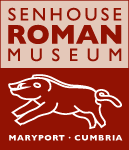Senhouse Roman Museum


The Senhouse Roman Museum’s dramatic location on the cliffs at Maryport gives an impressive view of the Solway Firth.
Voted Cumbria Tourism’s Visitor Attraction of the Year in 2018, it is home to one of the most significant Roman collections in the UK and is of international importance.
But this isn’t just another Roman museum – this is a very local collection. Many of its artefacts have been in the town of Maryport for nearly 2,000 years as they were recovered from the nearby Roman fort and civil settlement attached to it which were probably founded in the first century AD and rebuilt during the reign of the emperor Hadrian.
The museum displays the largest group of Roman military altar stones and inscriptions from any site in Britain and also has unique examples of Romano-British religious sculpture.
The museum’s collection was begun by John Senhouse, Lord of the Manor of Ellenborough, in 1570 and is the oldest in the country. He collected inscribed stones from the Roman fort and civilian town lying along the coastal ridge above and, as was the practice at that time, set them within the walls of the family’s mansion called Netherhall.
It was in the eighteenth century that Colonel Humphrey Senhouse began to record any carved stonework which was removed from the Roman fort to provide building stone for the new town of Maryport.
Since 1990, the museum and its collections have been housed in the Battery, a former Royal Naval artillery volunteer drill hall.
Getting here…
Follow the brown signs featuring small Roman helmets northward from the town centre. The nearest railway station is in Maryport. The Battery Sea Brows Maryport Cumbria CA15 6JD Full directions can be found here.Facilities
- Free parking
- Free admission for CA15 residents
- Tea & coffee
- Toilets
- Disabled access
- Picnic area
Did you know…?
You can see some of the stones removed from the Roman fort at Crosscanonby Church, up the coast north of Maryport.
Look for…
The stunning views from the museum’s observation tower, and see the full extent of the Roman site.






